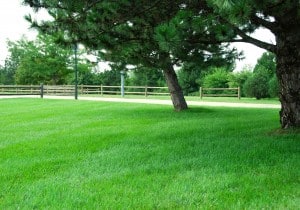
28 Jul Lawn Care Tips: A General Overview
 Whether a home or business, everyone wants a thick, lush, green stand of grass. Grass, the most prevalent plant in the world, is a cornerstone of the Omaha landscape. A healthy stand of grass contributes to: cooling temperatures around our homes; erosion control, ground water absorption, pollutant filtering, value to real estate and aesthetic pleasure. Through its numerous benefits to our environment and our way of life, grass can be said to be the most important part of any landscape. Grass can grow in almost any environment in the world yet it can be a real challenge to establish a thick carpet of turf in our own backyards. It requires much work and time, but with some education and a quality lawn care provider, you can spend less time caring for your lawn and more time enjoying it with family and friends!
Whether a home or business, everyone wants a thick, lush, green stand of grass. Grass, the most prevalent plant in the world, is a cornerstone of the Omaha landscape. A healthy stand of grass contributes to: cooling temperatures around our homes; erosion control, ground water absorption, pollutant filtering, value to real estate and aesthetic pleasure. Through its numerous benefits to our environment and our way of life, grass can be said to be the most important part of any landscape. Grass can grow in almost any environment in the world yet it can be a real challenge to establish a thick carpet of turf in our own backyards. It requires much work and time, but with some education and a quality lawn care provider, you can spend less time caring for your lawn and more time enjoying it with family and friends!
Here are the basics every homeowner should follow to help establish a hardy stand of grass. These are in order of importance so before jumping to the next “step”, be sure to satisfy the previous one.
1. Start with the proper soil profile, establish a well drained site and use a seed variety that fits your specific location.
2. Mow your lawn weekly with a sharp mulching blade at the upper height settings to help control weeds and encourage strong root growth.
3. If sufficient rainfall does not occur, water your grass at appropriate levels for the time of year. Less frequent, deep watering in the morning is ideal.
4. Aerate your soil at least one time per season to alleviate compaction and allow greater absorption of water, air and nutrients in the roots of grass plants.
5. Power rake your lawn every 2-5 years to keep thatch levels at or below ½”.
6. Fertilize your turf with the proper blend of nitrogen, phosphorous, potassium and several other micro nutrients required for healthy growth.
7. Use insecticides and pesticides judiciously to accommodate a balance of sufficient results at recommended levels while minimizing damage to non target pests.
Future entries will cover these tips more in depth and other important issues concerning your lawn and landscape.


